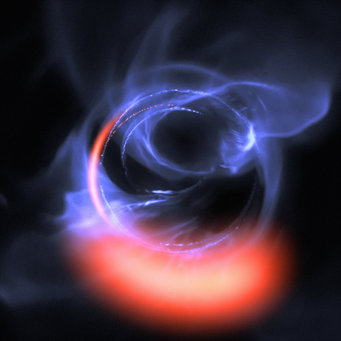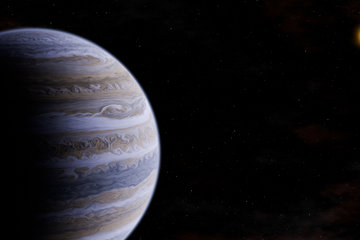Gruber Cosmology Prize for Frank Eisenhauer
The scientist at the Max Planck Institute for Extraterrestrial Physics is honoured for developing pioneering instruments
The 2022 Gruber Cosmology Prize recognizes Frank Eisenhauer of the Max Planck Institute for Extraterrestrial Physics for the revolutionary design of instruments that collected seemingly irrefutable evidence for the existence of a black hole at the center of our Galaxy. The citation honors the “unprecedented and exquisite” precision of his instrumentation. The prize is endowed with 500,000 US dollars.

In 2018, the Gravity experiment traced the behavior of various phenomena near Sagittarius A* (Sgr A*), a supermassive and therefore gravitationally voracious, invisible object near the center of our Galaxy. Thanks to Eisenhauer’s technical innovations, the Gravity team found that the orbit of stars and gas near the Galactic centre matches theoretical predictions consistent with the existence of a black hole. Eisenhauer’s mentor and longtime collaborator Reinhard Genzel shared the 2020 Nobel Prize in Physics with Andrea Ghez for his contributions to work on Sagittarius A*.
Gravity had its basis in an earlier experiment on which Eisenhauer developed breakthrough technology in imaging spectroscopy—the measurements of how matter affects the absorption and emission of light. The instrument is part of the “Spectrograph for Integral Field Observations in the Near Infrared” (Sinfoni) at the European Southern Observatory’s Very Large Telescope on Mount Paranal in Chile. It includes an adaptive optics system to correct the image blur from the Earth’s turbulent atmosphere developed under the lead of Henri Bonnet. In 2003, Sinfoni began observing stars operating under the great gravitational influence of Sgr A* as they execute their exceedingly rapid, highly eccentric orbits.
Two years later the group of German and French researchers around Eisenhauer and Genzel, Stefan Gillessen, Pierre Lena, Guy Perrin, and Thibaut Paumard began discussing an opportunity to observe an upcoming event involving one of those stars, S2. Having measured a precise orbit of S2 after the first peri-passage in 2002, they were now able to calculate that in 2018 the star would reach the part of its orbit where it would again pass closest to Sgr A*, a distance of only 17 light-hours. Combining the observing power of all four 8-metre telescopes at Paranal (through a process called interferometry) meant that the experiment could achieve the necessary thousandfold improvement in sensitivity over earlier interferometers necessary to resolve the resulting relativistic effects.

Eisenhauer’s designs did indeed wind up revolutionizing several kinds of instrumentation, including imaging detectors, laser metrology, and dual-beam operations. Those results include: precise measurements of Sgr A*’s general relativistic influence on S2; as well as observations of gas orbiting close to the “last stable orbit”—the point before which it succumbs to the gravitational tug of Sgr A* and disappears from sight forever. Together this data provides enough evidence to satisfy the astronomical community that Sgr A* is indeed a black hole. This is also confirmed by the recently published image of Sagittarius A*.
Among Gravity’s other significant contributions to astronomy: A determination of the distance between the Sun and the Galactic center at a level of precision ten times greater than previous measurements (a calibration that other astronomers will use as a reliable first step in tracing the evolution of the universe on the largest scales). A test of Einstein’s general relativity using supermassive black holes at the highest level of precision to date.
As Gravity’s advocates hoped, Eisenhauer’s innovations in technology—the ones for which he is receiving the 2022 Gruber Prize in Cosmology—have changed astronomy beyond just the study of Sgr A*. Other astrophysicists have already begun using Sinfoni and Gravity instrumentation to study distant star-forming galaxies, black holes at the centers of nearby galaxies, and planets orbiting stars within our own Galaxy.

Gravity is currently being upgraded with new adaptive optics, laser guide stars, and wide field capabilities. Called Gravity+, this project will soon boost optical interferometry to the next level, then also opening up the extra-galactic sky for highest resolution observations, and providing sharper and sharper images for the observation of exoplanets.
The development of Sinfoni, Gravity and Gravity+ were and are made possible by the generous support from the Max Planck Society and the Max Planck Foundation – an independent, non-profit organization for private supporters of top research in the Max Planck Society.
**********
Frank Eisenhauer will receive the 500,000 US dollars award as well as a gold laureate pin at a ceremony that will take place on August 2 at the XXXIst General Assembly of the International Astronomical Union in Busan, Korea. Previous honors for Eisenhauer include the Tycho Brahe Medal of the European Astronomical Society for his leadership of the Sinfoni and Gravity instruments, the Stern-Gerlach Medal of the German Physical Society for his pioneering work in high-resolution infrared astronomy, and the Jackson-Gwilt Medal of the Royal Astronomical Society for the development of astronomical instrumentation. He was elected to the French Academy of Sciences.
The Gruber Cosmology Prize honours leading figures from the fields of cosmology, genetics, and neuroscience whose pioneering discoveries lead to fundamental advances in our understanding of the universe. The Gruber International Prize Program honors individuals in the fields of Cosmology, Genetics and Neuroscience, whose groundbreaking work provides new models that inspire and enable fundamental shifts in knowledge and culture. The Selection Advisory Boards choose individuals whose contributions in their respective fields advance our knowledge and potentially have a profound impact on our lives. The Gruber Foundation was established in 1993 by the late Peter Gruber and his wife Patricia Gruber. The Foundation began its International Prize Program in 2000, with the inaugural Cosmology Prize.
HAE / HOR














